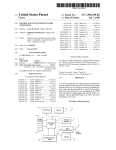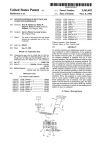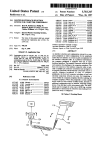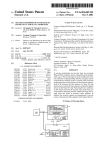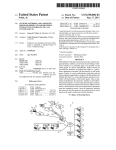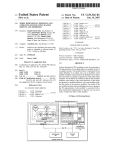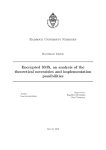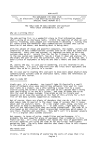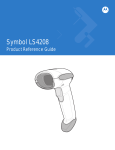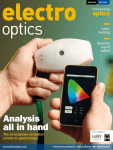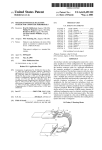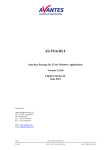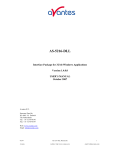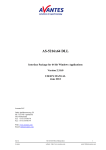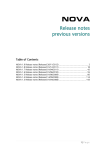Download Data reader and methods for imaging targets exposed to high
Transcript
US007461790B2 (12) United States Patent (10) Patent N0.2 McQueen et al. (54) US 7,461,790 B2 (45) Date of Patent: Dec. 9, 2008 DATA READER AND METHODS FOR IMAGING TARGETS EXPOSED TO HIGH 5,814,803 A 6,155,488 A 9/1998 Olmstead et al. .......... .. 235/462 12/2000 Olmstead et al. .......... .. 235/440 INTENSITY ILLUMINATION 6,311,895 B1 11/2001 75 _ ( ) Inventors‘ $381562?‘hicQlll‘ielgtEgigéne’ 3R ’ an y ' “r a ’ ' ans“ e’ OH (Us) ( * ~ . 6,520,415 B1* 2/2003 235/462.25 6,708,883 B2 * 3/2004 Krichever ......... .. 235/462.01 McMaster ............ .. 235/462.35 1/2006 2006/0163355 A1 7/2006 Olmstead et al. .......... .. 235/454 Barkan et al. ............. .. 235/454 OTHER PUBLICATIONS ) Product Data Sheet: Sony 2048-pixel CCD Linear Sensor (B/W) for ~ ( ) Nonce' 1/2003 Reddersen et al. 2006/0016893 A1* (73) Assignee: Datalogic Scanning, Inc., Eugene, OR US Olmstead et al. ..... .. 235/46241 6,505,778 B1 ~ ~ - Single 5V Power Supply Bar-code Reader ILX554B, downloaded SubJeCt. to any dlsclalmer’. the term Ofthls from: http://www.datasheetsite.com/datasheet/ILXS54, visited May patent 15 extended or adjusted under 35 b b 0 da 5 USC‘ 154( ) y y ' 10 2007 13 ’ ’ PPS‘ User Manual: Avantes Avasort for AvaSpec-102/256/1024/2048 ver sion 6.2 User’s Manual, pp. 27-29, (Aug. 2004) downloaded from: (21) Appl- N05 11/6921664 http://www.avantes.com, visited May 10, 2007, 7 pps. _ (22) Takaya Yasuda et al., Variable-Integration-Time Image Sensor for Flled: Mar- 281 2007 (65) Wide Dynamic Range, 2003, downloaded from: http://www.us.de sign-reuse.com/articles/article7411.html, visited May 13, 2007, 11 pps. Prior Publication Data US 2007/0241192 A1 Oct. 18, 2007 * cited by examiner Related US. Application Data _ _ _ P1’imary ExamineriDaniel St-Cyr _ (74) Attorney, Agent, or FirmiStoel Rives LLP (60) Prov1s1onal appl1cat1on No. 60/744,261, ?led on Apr. 4, 2006- (57) (51) A data reader such as for example an imaging reader with a Int- Cl- G06K 7/14 ABSTRACT (2006-01) CCD or CMOS imager or the like, that acquires an image of (52) US. Cl. ................................ .. 235/454; 235/462. 14 an item to be read' A Certain type of sensor has been found to (58) Field of Classi?cation Search ............... .. 235/454, exhibit different outputs depending upon the light intensity (56) 235/462.01, 462.14, 462.29, 462.32, 462.35, 235/ 462.45, 455, 462 See application ?le for complete search history. References Cited level: (1) standard output whereby the sensor outputs a signal corresponding to the image collected and (2) inverted output whereby the sensor outputs an inverted signal when the light mtensrty h1gh1y saturates the sensor. Takmg advantage of th1s inverted output, systems and methods are then employed by the data reader to convert or otherwise re-invert this inverted U.S. PATENT DOCUMENTS signal in order to read an optical code that, for example, might 4,499,595 A 4,538,060 A 4,631,588 A 5,008,696 A * 5,770,847 A * 2/1985 Masaitis etal. .............. .. 382/9 8/1985 Sakai et al. 12/1986 Barnes et al. 4/1991 6/1998 ..... . . . .. otherwise have been above the upper exposure limit of the sensor/reader and thus not decodable. 235/472 358/149 Miida et al. ............... .. 396/104 14 Claims, 4 Drawing Sheets Olmstead ............. .. 235/462.35 we hml hum W mm n 1 m we" US. Patent Dec. 9, 2008 Sheet 1 of4 US 7,461,790 B2 Fig. 1 aw, (Prior art) Readout; ate cmmwm Mme gal-eater @920 e .5.e mt n r :1’\ \ SHEEN Fig. 1'2‘ (Prior art) US. Patent Dec. 9, 2008 Sheet 2 of4 US 7,461,790 B2 LEVEL; INVERTED MODE 20 LOW LIGHT LEVEL; STANDARD MODE 1O 15 Fig. 3 US. Patent Dec. 9, 2008 Sheet 3 of4 US 7,461,790 B2 52 5O US. Patent Dec. 9, 2008 Sheet 4 of4 US 7,461,790 B2 Activate scanning; set inverted mode to inactive; start scanning time limit timer Fig. 5 100 41— > Scan and attempt decode If good decode, acknowledge and transmit 1 06 1 08 Deactivate activated > scanning time limit ii>fYeS4> \‘wrtias data been decode/d?” . / scanning 1 10 \ inverted mode . active? 'Yes* i No V 112 Check exposure 116 4 ls exposure time 126 at in I _ , \ maximum limit? / “ ls sensor exposure ‘\ /§‘—C\ TOO dark correct? 1 14 ' r)? \\ Too bright V \‘ ” \ 1 No Yes mode to active, ¢ N0 invert sensor / data destined for 1 2O decoding Calculate & set Calculate and set longer shorter exposure time based upon / 1 1 8 1 28 l Set inverted ” 1 Yes ,r" algorithms desired sensor exposure time / Output VS based upon desired sensor present output 1 24 i p 15561512110 p \ / ls exposure time exposure Lemme“ by time 4*No predetermined increment \‘mgxlmum at'nv-enedim-iie ” l \ 122 Yes Set inverted mode to 123 / v V V V inactive 1 US 7,461,790 B2 1 2 In a preferred con?guration, the data reader comprises an DATA READER AND METHODS FOR IMAGING TARGETS EXPOSED TO HIGH INTENSITY ILLUMINATION imaging reader, employing a sensor such as a CCD, that acquires an image of an item to be read. A certain type of sensor has been found to exhibit different outputs depending upon the light intensity level: (1) standard output Whereby the RELATED APPLICATION DATA sensor outputs a signal corresponding to the image collected and (2) inverted output Whereby the sensor outputs an This application claims the bene?t under 35 U.S.C. § 119 (e) of US. Provisional Patent Application No. 60/744,261 inverted signal When the light intensity highly saturates the sensor. Taking advantage of this inverted output, systems and ?led Apr. 4, 2006 hereby incorporated by reference. methods are then employed by the data reader to convert or otherWise re-invert this inverted signal in order to read an BACKGROUND optical code (for example) that otherWise Would have been The ?eld of this disclosure relates to imaging and collec tion devices and in particular to methods and devices for above the upper exposure limit of the sensor/reader. illumination, collection and imaging for optical code reading the folloWing detailed description of preferred embodiments, and other data and image capture devices. Image capture and other data reading devices are used to Which proceeds With reference to the accompanying draW Additional aspects and advantages Will be apparent from 1ngs. read optical codes, acquire data, and capture a variety of images. One common data acquisition device is an optical code reader. Optical codes typically comprise a pattern of BRIEF DESCRIPTION OF THE DRAWINGS 20 dark elements and light spaces. There are various types of FIG. 1 is a perspective vieW of a CCD sensor usable in a optical codes, including 1-D codes (such as UPC and EAN/ system and method according to a preferred embodiment. JAN barcodes) and 2-D codes (such as PDF-417 and Maxi code). For convenience, some embodiments are described herein With reference to capture of 1-D barcodes. HoWever, FIG. 2 is a block diagram of the CCD sensor of FIG. 1. the embodiments may also be useful for other optical codes and symbols as Well as other images such as ?ngerprint cap ture, and nothing herein should be construed as limiting this disclosure to optical codes or particular types of codes. One type of data reader is an imaging reader that employs FIG. 3 is a graphical representation of detected signals 25 from a test barcode according to a preferred method. FIG. 4 diagrammatic vieW of a data reader according to a preferred embodiment. FIG. 5 is a How chart of a method of data reading according to a preferred embedment. 30 DETAILED DESCRIPTION OF PREFERRED EMBODIMENTS an imaging device or sensor array, such as a CCD (charge coupled device) or CMOS (complementary metal oxide semiconductor) device. Imaging readers can be con?gured to read both 1-D and 2-D optical codes, as Well as other types of optical codes or symbols and images of other items. When an imaging reader is used to read an optical code, an image of the optical code or portion thereof is focused onto a detector Throughout the speci?cation, reference to “one embodi 35 that a particular described feature, structure, or characteristic is included in at least one embodiment. Thus appearances of the phrases “in one embodiment,” “in an embodiment,” or “in array. Some imaging readers are capable of using ambient some embodiments” in various places throughout this speci light illumination, While other imaging readers employ a light source to illuminate the item being scanned. It is desirable for optical code scanners to have a Wide dynamic range of usable illumination conditions over Which 40 ?cation are not necessarily all referring to the same embodi ment. Furthermore, the described features, structures, char acteristics, and methods may be combined in any suitable manner in one or more embodiments. In vieW of the disclo they may operate. Typically, imaging optical code scanners sure herein, those skilled in the art Will recogniZe that the are required to Work in very loW light conditions (such as in a dimly lit Warehouse With ambient light intensity on the order ment,” or “an embodiment,” or “some embodiments” means 45 various embodiments can be practiced Without one or more of full sunlight With light intensity over 100,000 lux). A lux is a the speci?c details or With other methods, components, mate rials, or the like. In other instances, Well-known structures, unit of luminous incidence equal to one lumen per square materials, or operations are not shoWn or not described in of tens of lux) as Well as in high light conditions (such as in meter. This large variation in ambient light conditions creates a required dynamic range of 10,000>< or more. One possible method of compensating for the large variation of ambient light conditions is to equip the scanner With dynamic aper tures or electronically adjustable attenuators. The present detail to avoid obscuring aspects of the embodiments. 50 inventors have recogniZed that such compensation mecha nisms add cost and complexity to the system and thus it Would be desirable to provide a system that is entirely solid state, With no moving parts. The design challenge is to create a simple device With a broad dynamic range, Which usually means electronically varying the integration time of the sen 55 sor as the primary means of exposure control. 60 utiliZing imaging technology. For conciseness of description, the detector arrays are described as CCD arrays, but other suitable detectors may be implemented such as CMOS. The present inventors have found that certain sensors Methods and devices are disclosed for improving reading saturate the sensor array or portions thereof. exhibit tWo output modes depending upon the light intensity level namely a ?rst standard mode Whereby the sensor outputs a signal corresponding to the image collected and a second inverted mode Whereby the sensor outputs an inverted signal When the light intensity highly saturates the sensor. One such SUMMARY of optical codes or other items being imaged, particularly Where certain light conditions (eg bright sunlight) tend to Preferred embodiments Will noW be described With refer ence to the draWings. To facilitate description, any reference numeral representing an element in one ?gure Will represent the same element in any other ?gure. Methods and devices according to the embodiments described are particularly useful for presentation scanners 65 sensor is the Model ILX554B CCD linear sensor manufac tured by Sony Corporation. The ILX554B model is a 2048 pixel CCD linear sensor, details of Which are available from US 7,461,790 B2 4 3 the product data sheet hereby incorporated by reference. In one embodiment, the scanner has tWo modes of opera According to the product data sheet (at page 3), the ILX554B tion, normal (or standard) and inverse (or inverted) video sensor becomes saturated When exposure reaches about 0.004 lux~sec. This sensor outputs an inverted signal When exposure reaches a highly saturated level on the order of several times modes. When the scanner is ?rst triggered, it starts in normal video mode and begins trying to set an exposure level that places the video signal Within a desired optimum range. Dur ing this normal mode, the video signal is treated in the signal (or more) the saturation level. processing chain as a non-inverted signal, and all calculations FIG. 1 illustrates the CCD sensor 5 as a 22 pin DIP (dual inline package), With a block diagram 7 of the circuit thereof in the processing and decoding algorithms use this assump illustrated in FIG. 2. The CCD sensor 5 includes a linear array tion. If, after some ?xed time or number of captured frames of data, a successful decode has not occurred and it is deter of 2048 active pixels, shoWn in FIG. 2 as elements S1 through S2048. The pixels of this sensor are rectangular having a mined that the sensor (or sensors) is (are) in a high illumina greater height (on the order of 5 6 pm) than Width (on the order of 14 um) providing largerpixel area (i.e., greater sensitivity). tion condition (i.e. highly saturated), the system changes to inverted mode, and the data is deliberately re-inver‘ted by the signal processing. The data may be re-inver‘ted by the A/D FIG. 3 is a graphical representation of the output of the converter or at any other suitable place in the signal process ing/decoding chain. At the same time, the system starts to adjust the exposure longer and longer in order to ensure that the sensor is placed in the highly saturated state. With each linear sensor 5 along a ?eld of vieW or scan line 15. The loWer portion of FIG. 3 illustrates a test target 10 having a central section comprised of light space 12 and dark bar 14 that for test purposes corresponds to the bar and space of a barcode. lengthening of the exposure, decoding is attempted. If indeed The top portion of FIG. 3 illustrates tWo graphical represen tations of the output of the sensor along scan line 15. Output signal 20 illustrates a loW light level Where the target 15 is illuminated via ambient light at a moderate light intensity condition, such as on the order of 300 lux. At this ambient 20 inverted video at one of the exposure selections, then upon re-inversion by the signal processing system, this data should produce a successfully decoded label. If decoding is not suc light intensity level, the output signal 20 readily distinguishes betWeen an output level 22 corresponding to the bar 12 and an cessful, the process of continually lengthening the exposure 25 output level 24 of the space 14. Thus this output signal may be sent to a signal processor for decoding. Technically, the out put of the model ILX554B CCD is such that the brighter/ higher light signal corresponding to the space 14 is a loWer voltage and the darker/loWer light signal corresponding to the there is su?icient illumination to cause the sensor to output While inverting the data continues until a limit is reached, such as an elapsed time or number of frames since being triggered, or a maximum exposure. At this point, the scanner may revert to normal video mode and the process starts from the beginning as described above. This system and method 30 thus may provide a larger dynamic range. bar 12 is a higher voltage. The curves of signals 20 and 30 FIG. 4 illustrates a handheld data reader 50 such as may be shoWn in FIG. 3 have been inverted by the A/D (analog to digital) converter of the system or elseWhere in the signal equipped With the linear CCD described above. This reader 50 includes a head portion 52 connected to a handle portion 54. A WindoW 53 is disposed in the front section of the head processing chain. The CCD includes the capability of changing exposure. 35 operation, including light exposure. As the intensity of the ambient light level increases, the system driving the CCD has the capability of compensating for the increasing light by adjusting exposure. If the sensor has an output level that indicates the sensor is exposed to too much light, the control system attempts to electronically reduce exposure time. HoW ever in high light conditions such as in direct sunlight, the sensor may reach its minimum exposure time and yet still be saturated. When the sensor is saturated, the output signal is such that the difference betWeen the respective signals corre sponding to the bar 12 and space 14 of the optical code cannot be readily distinguished. At a certain very high saturation level, the output signal 30 of CCD is essentially inverted, namely the output level 34 corresponds to the light space 14 40 45 The sensor’s output or the data representing the output is then re-inver‘ted at some point in the signal processing/decod ing chain and the resulting optical code data may then be decoded. In one method, the system automatically determines When the light ?ux is suf?ciently high to result in an inverted signal, and When this condition occurs, the system inverts the data during signal processing (Which may be described as “re-inverted”) Which then produces a decodable signal. The data may be re-inver‘ted by the A/ D converter or at any other suitable place in the signal processing/ decoding chain the reader is preferably equipped With illumination sources that are activated during scanning or during other suitable conditions. FIG. 5 is a How chart illustrating a processing method 100 according to a preferred embodiment. The method includes the steps of: At Step 102, activating scanning, starting the scanning limit timer, and setting inverted mode to inactive. Preferably, at the start of scanning (e. g. on each trigger pull of the scan ner) or after a successful scan, the mode is set to non-inverted, 50 the non-inverted mode being the more standard operating mode. At Step 104, scanning and attempting to decode. At Step 105, if good decode is accomplished, acknoWledg ing good read (typically by emitting an audible “beep” tone) and the output level 32 corresponds to the dark bar 12. HoW ever, unlike the loWer intensity saturation condition Where the signals corresponding to the bar and space cannot be distin guished, the high saturation level output signal 30 includes an output level 34 (corresponding to the light space 14) that is distinguishable from the output level 32 (corresponding to the dark bar 12). portion 52. This unit 50 is provided With a trigger 56 that is manually actuable to initiate reading operation. Other suit able reader con?gurations may be employed. Though this reader may operate solely via ambient light, The system includes a control system Which controls CCD and transmitting the data. 55 60 At Step 106, determining (1) if scanning has been activated for a time period greater than scanning time limit (eg if the scanning limit timer has timed out) or (2) if the data has been decoded, and if yes to either (1) or (2) proceed to Step 108 and deactivate/stop scanning and if no, proceed to Step 110. At Step 110, determining if inverted mode is activated, if yes, proceed to Step 122, if no proceed to Step 112. At Step 112, checking sensor exposure and at Step 114 determining if sensor exposure is correct. If exposure is cor 65 rect, return to Step 104. If exposure is too dark, proceed to Step 126. If exposure is too bright, proceed to Step 116. One method of determining Whether exposure is correct is to com pare a measured value of the output signal level to a preferred US 7,461,790 B2 5 6 or target range. If the signal level is above the target range, the exposure is too bright. If the signal level is below the target may be omitted as scanning time out at Step 106 Would be reached and the system may attempt re-scan at Step 102. range, the exposure is too dark. Returning to Step 104 (in the inverted mode from Step 122 Where the exposure is too dark (meaning there is insu?i or 124), since reading (decoding) Was unsuccessful in the cient light illuminating the optical code), at Step 126 deter standard, non-inverted mode, decoding is again attempted mining Whether exposure time is at maximum limit. If yes, With inverted data. If the CCD achieves the highly saturated state and outputs inverted video, the decoding at Step 106 returning to Step 104, if no proceeding to Step 128. At Step 128, setting a longer exposure time. The longer (With inverted data from Step 120) may prove successful. exposure time may be calculated based upon desired sensor When operating in the inverted mode, the system then re output relative to current signal level. Alternately, the expo inverts the data during processing (for example at the A/D sure time may be increased by a set increment or some other converter or elseWhere in the signal processing chain) in order to produce a decodable signal. To further explain inverted mode processing, it may be suitable methodology. Once the neW (longer) exposure time is set, proceeding to Step 104 to attempt another scan. If it is determined at Step 114 that the exposure is too light useful to describe typical/ standard processing. In optical code reader processing, there is typically a ?xed relationship betWeen the voltage level of a signal representing the light and (meaning there is too much light illuminating the optical code), at Step 116 determining if exposure time is at mini mum limit. If yes, proceeding to Step 120, if no proceeding to Step 118. At Step 118 setting a shorter exposure time. The shorter exposure time may be calculated based upon desired sensor 20 output relative to current signal level. Alternately, the expo sure time may be decreased by a set increment or some other suitable methodology. Once the neW (shorter) exposure time is set, proceeding to Step 104. If at Step 116 it is determined that the exposure time is already at the minimum time, the exposure level is too bright and there is no further exposure reduction that can be made, the method infers that processing may be successful in the inverted mode. Thus proceeding to Step 120, inverted mode is activated (inverted mode set to active) Whereby sensor data is dark areas of a bar code, and the bar code’s actual light and dark physical features. For example, at the sensor output, this relationship may be that a more positive voltage represents a brighter area, or, depending upon the sensor, a brighter area may be represented by a loWer voltage level. In either case, a typical system Will be designed to process the data based upon the knoWn relationship betWeen the sensor’s output and the bars and spaces of a barcode, so as to correctly process the 25 30 encoded data. The same Will be true through the digital pro cessing chain of a typical reader. When the analog sensor voltage is converted into a digital or logic level, there Will be some ?xed relationship maintained betWeen the particular logic level and the actual bar and space data. The decoding algorithms in the reader make use of the ?xed, knoWn rela inverted for processing by the decoding algorithms. The tionship betWeen the incoming digital data and the original methodmay proceed from Step 120 to Step 122 or alternately, the method may skip Step 122 and proceed either directly to bars and spaces of the encoded information. Step 124 or to Step 104. At Step 122, determining Whether exposure time (during In a preferred system/method herein, the relationship 35 inverted mode) is at maximum limit. If yes proceeding to Step 123; if no proceeding to Step 124. The ?rst time through (coming from Step 120), the exposure time is at the minimum limit so the process Will determine at Step 122 that the pro ceed to normal, non-highly illuminated condition, the voltage levels 40 At Step 124, lengthening (or increasing) exposure time by a given increment and returning to Step 104. The purpose of Step 124 is to incrementally increase exposure and if the exposure Was too bright at the minimum exposure setting (in 45 standard, non-inverted mode), the exposure setting is incre mentally adjusted upWard toWard the maximum exposure setting, thereby enhancing conditions for causing the sensor to output inverted video (i. e., in the high saturation level). A preferred increment of exposure lengthening may be on the order of l mS. The increment may be larger or smaller. A smaller increment, for example, on the order of 0.5 mS. This preferred increment is fairly smallisuch a small increment is preferred because it Would appear that the inverted-mode operates most successfully in a fairly narroW exposure range. Though an incremental increase of exposure is a preferred method, other methods of adjusting the exposure may be implemented such as increasing by a calculated amount based on some factor. Alternately, the method may immediately attempt maximum exposure and if not successful, attempt a series of loWer exposures. At Step 123, setting inverted mode to inactive and then 50 and their relationship to the bars and spaces of a barcode Will have one state, for example, a high voltage level Will be treated through the system as indicating a White space in the bar code, and a loW voltage level Will indicate a black bar. When the system determines that the sensor is in its highly illuminated condition, the system’s state Will sWitch to the inverted mode and the relationship betWeen the voltage levels and the barcode features Will be inverted by the system. The reversed relationship betWeen voltage and bar code features Within the system in this inverted mode is used to compensate for the inverted data issuing from the sensor. There are several methods by Which the system may oper ate in an inverted processing mode, including: (1) analog hardWare such as a single transistor stage, Whereby the actual voltage signal is inverted; (2) digital hardWare or logic signal 55 inverter; (3) a digital inverter circuit that outputs a voltage representing the opposite logic-level as its input, the inverter circuit serving as the basic logic gate to sWap betWeen those tWo voltage levels; and (4) softWare. In the softWare method, 60 proceeding to Step 104. Upon reaching Step 123, the method has cycled through the process having upped the exposure to the maximum. Since decode has been unsuccessful in the inverted mode, the inverted mode is set to inactive and the method then scan attempts decode in standard mode. Step 123 betWeen the sensor data levels and the bars and spaces this data is assumed to represent, may take one of tWo states, depending upon Whether or not the sensor is in its highly illuminated, inverted condition. When the sensor is in its 65 the signal may be inverted in softWare at any suitable stage including at the pre-processing stage or at the decode stage. In a preferred con?guration, the data reader may be pro vided With multiple sensors. The sensors may be indepen dently controlled or controlled by a common controller. In one preferred method, once the method of controlling one of the sensors is sWitched to inverted mode (pursuant to Step 120 above), the method of controlling the other sensor is also sWitched to inverted mode. US 7,461,790 B2 8 7 Wherein the system is operative to highly saturate the sen In another control scheme, dual sensors are separately con sor by increasing exposure time for enhancing probabil trolled and portions combined. Certain methods for process ity of the sensor to generate an inverted output signal. 4. A system according to claim 3 Wherein the exposure time ing such a dual sensor system are disclosed in Olmstead et al. U.S. Published Application No. US 2006-0163355 hereby incorporated by reference. is increased incrementally. In yet another control scheme, either a second control sensor, or a portion of the primary sensor, may be used to provide informational feedback to the system for exposure sensor Wherein the sensor is operative to generate an inverted 5. A method of operating an imaging system including a output signal When the sensor is subjected to high intensity illumination above a certain operating range, comprising the steps of if exposure on the sensor is too high, adjusting exposure by control. The control sensor may be designed, such as With a ?lter or screen, that reduces the overall exposure thereby allowing the control sensor to sense the exposure level at high light levels, i.e., those light levels that normally Would create shortening exposure time; highly saturated or oversaturated levels in sensor 5. The sys tem could then use the output from the control sensor to determine Whether the output from the sensor 5 is inverted such as by comparing the output of the control sensor to the output of the sensor 5. If the output from the control sensor if exposure on the sensor is still too high even after expo sure time has been adjusted to a minimum, then (a) increasing the exposure time and (b) processing the out put signal from the sensor by reinverting the signal. 6. A method according to claim 5 Wherein the step of increasing exposure comprises increasing the exposure time indicates a high light level (e. g. a level that Would be expected to be highly saturated to the sensor 5) and the output from the sensor 5 otherWise appears to be in the normal range, then it incrementally. 20 can be inferred With a reasonably high probability that the sensor 5 output is inverted and thus signaling this alternate system/method to sWitch to inverted mode. Thus systems and methods for data reading and image capture have been shoWn and described. It is nevertheless intended that modi?cations to the disclosed systems and methods may be made by those skilled in the art Without 25 exposure time; ful decode, deactivating scanning. 9. A method according to claim 5 further comprising The invention claimed is: 30 tion re?ecting from the item and to generate an output signal corresponding thereto, Wherein the sensor is operative to generate (a) a ?rst output sianal When the 35 ating range and (b) a second output signal that is inverted subjected to high intensity illumination above the cer invert the ?rst output signal from the sensor. 2. A system according to claim 1 Wherein the processor is operative to process an output signal from the sensor (a) in a standard mode When the sensor is subject to illumination Within a standard operating range and (b) in an inverted mode When the sensor is subjected to high intensity illumination above a certain operating range and becomes highly saturated and generates an inverted output signal. 3. A system for data reading of an item, comprising: scanning; 40 45 sure time, and (b) upon reaching maximum exposure time Without a successful decode, deactivating scan ning. 50 When the sensor is subjected to high intensity illumina tion above a certain operating range; 55 sensor is subjected to high intensity illumination above a sensor is inverted by signal processing, (2) incrementally increasing exposure time. 60 11. A method according to claim 10 Wherein the step of incrementally increasing exposure time comprises incremen sensor is subject to illuminatmon Within a standard oper tain operating range and becomes highly saturated and generates an inverted cutput signal, upon determining that exposure time has been adjusted to a minimum limit and exposure is still too high, (1) sWitching to an inverted mode Wherein data from the certain operating range and becomes highly saturated; a processor for processing and decoding the output signal ating range and (b) in an inverted mode When the sensor is subjected to high intensity illumination above a cer 10. A method of image processing comprising the steps of providing a sensor for an imaging system Wherein the sensor is operative to generate an inverted output signal tion re?ecting from the item and to generate an output from the sensor, Wherein the processor is operative to re-invert the inverted output signal from the sensor, Where in the processor is operative to process an output signal from the sensor (a) in a standard mode When the if scanning has not exceeded scanning time limit, deter mining if processing is in the inverted mode; if processing is not in the inverted mode, proceeding to standard mode exposure setting; if processing is in the inverted mode: (a) increasing the exposure time and attempting processing and decoding in the inverted mode until reaching a maximum expo a sensor arranged to receive a return signal from illumina signal corresponding thereto, Wherein the sensor is operative to generate an inverted output signal When the if good decode accomplished, acknowledging good read and transmitting data; if good decode not accomplished, determining if scanning has exceeded scanning time limit; if scanning has exceeded scanning time limit, deactivating relative to the ?rst output signal When the sensor is tain operating range and becomes highly saturated; a processor for processing and decoding the output signal from the sensor, Wherein the processor is operative (a) to invert the inverted second output signal and (b) to not activating scanning; upon activating scanning, setting processing mode to stan dard mode; scanning and attempting to decode; a sensor arranged to receive a return signal from illumina sensor is subjected to illumination beloW a certain oper after each increment. 8. A method according to claim 5 further comprising: increasing the exposure time until reaching a maximum upon reaching maximum exposure time Without a success departing from the underlying principles of set forth herein. 1. A system for data reading of an item, comprising: 7. A method according to claim 6 further comprising increasing the exposure time by a lmS increment, processing and attempting to decode in the inverted mode 65 tally increasing exposure by a given increment and re-scan ning and attempting decode in the inverted mode. 12. A method according to claim 11 further comprising repeating the steps of incrementally increasing exposure time and re-scanning and attempting decode until a successful decode or until scanning time limit has been reached. US 7,461,790 B2 10 13. A method of image processing comprising the steps of output signal When the sensor is subjected to illumination intensity in a normal operating range and operative to gener ate an inverted output signal that is inverted relative to the standard output signal When the sensor is subjected to high intensity illumination above a certain operating range, com providing a sensor for an imaging system Wherein the sensor is operative to generate (a) a ?rst output sicmal When the sensor is subjected to illumination below a certain operating range and (b) a second output signal that is inverted relative to the ?rst signal When the sensor is subjected to high intensity illumination above a cer tain operating range; compensating for the inverted second output signal from the sensor by processing the inverted second output sig nal in an inverted processing mode. 14. A method of operating an imaging system including a sensor Wherein the sensor is operative to generate a standard prising the steps of processing the standard output signal from the sensor in a standard processing mode; 10 processing the inverted output signal in an inverted pro cessing mode. UNITED STATES PATENT AND TRADEMARK OFFICE CERTIFICATE OF CORRECTION PATENT NO. : 7,461,790 B2 Page 1 of 1 APPLICATION NO. : 11/692664 DATED INVENTOR(S) : December 9, 2008 : McQueen et a1. It is certified that error appears in the above-identi?ed patent and that said Letters Patent is hereby corrected as shown below: Column 2 Line 26, before “diagrammatic” insert --is a--. Column 5 Line 39, after “Step 122 that” insert --exposure time is not a maximum limit and thus--. Line 40, after “proceed to” insert --Step 124.--. Column 7 Line 34, Line 61, Line 63, Line 67, change “sianal” to --signal 2--. change “wherein” to --Wherein--. change “illurninatmon” to --illuminati0n--. change “output” to --output--. Column 8 Line 16, change “reinventing” to --re-inventing--. Column 9 Line 3, change “sicmal” to --signal--. Signed and Sealed this Twenty-third Day of June, 2009 term JOHN DOLL Acting Director ofthe United States Patent and Trademark O?ice











